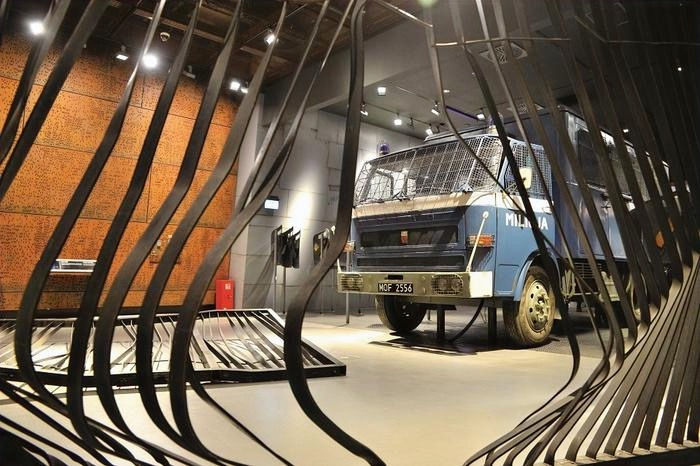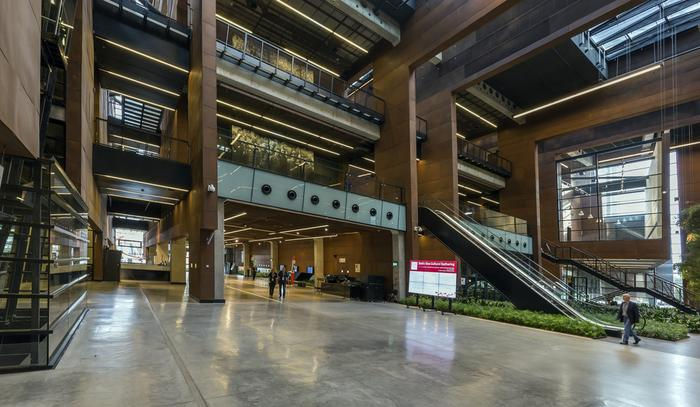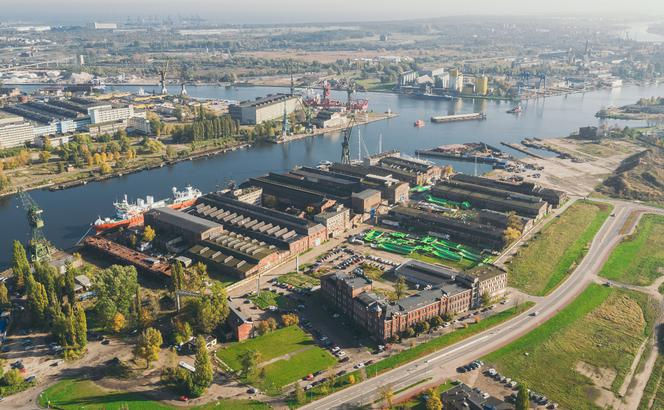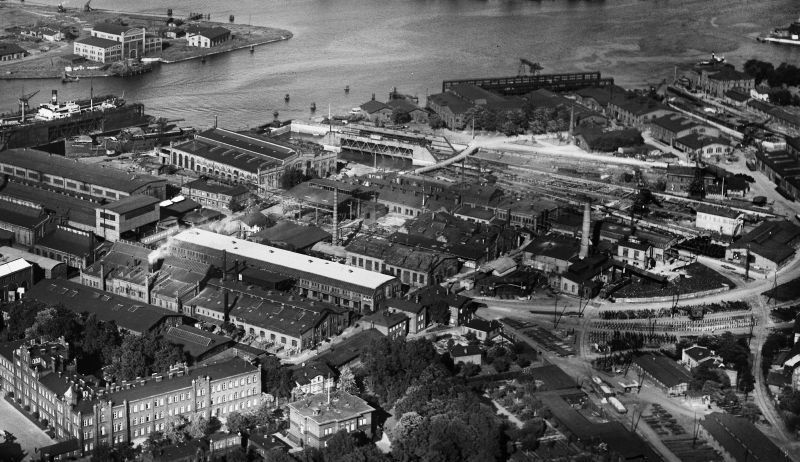European Solidarity Center in Gdańsk - from revolution to dialogue
- Damian Brzeski

- Apr 9, 2023
- 11 min read
Updated: Oct 20, 2024
In August 1980, a revolution began in Gdańsk, which changed the face of Poland and Europe. Workers of the Gdańsk Shipyard led by Lech Wałęsa performed with 21 postulates, demanding freedom and justice.
Their strike caused a wave of solidarity throughout the country and led to the creation of the first independent trade union in the communist block. It was the beginning of the end of the totalitarian system and the beginning of the new Democratic Age.
In the former shipyard, where Solidarity was born, a European Solidarity Center was established - a cultural institution that consolidates the memory of this historical civic success.
ECS is not only a museum that presents the history of solidarity and opposition movements in Central and Eastern Europe. It is also a place of dialogue and inspiration for contemporary citizens who want to build a better world based on the values of solidarity and democracy.
In this article, we will tell about the ECS history and mission, about its architecture and exhibitions, about its educational, scientific and social activities.

European Solidarity Center - History and mission of an institution commemorating the Solidarity Revolution and the fall of communism in Europe
Gdańsk is a city with a rich and turbulent history that played a key role in shaping the fate of Poland and Europe. It was here in August 1980 that the Solidarity Movement was born, which initiated a wave of democratic changes on our continent.
It was here that the European Solidarity Center was created - not only the museum commemorating these events, but also the place of dialogue and inspiration for contemporary citizens. In this article, we will tell you about the history and mission of this unique cultural institution, which connects the past, present and future. We invite you to read!
The European Solidarity Center (ECS) is an institution based in Gdańsk, established on the basis of a contract of November 8, 2007 on the creation and conduct of a joint cultural institution under the name of the European Solidarity Center, concluded between the Minister of Culture and National Heritage, the Pomeranian Voivodeship, the city of Gdańsk, The Solidarity Independent Self -Governing Trade Union and the Solidarity Center Foundation. The aim of the Center's activity is to "disseminate the Heritage of Solidarity in Poland and other countries and active participation in the construction of European identity."
"The headquarters of the center with an area of 25,349.75 m² was established in Gdańsk, in the Młyniska district, in the young city at Solidarności Square, near Gate No. 2 and the monument to the fallen shipyard workers. The facility covers an area of about one hectare and has 5 floors and an underground parking lot about 286 places. The project was selected by the competition from among 58 works. The architectural competition was won by the team from the Fort studio from Gdańsk. The construction cost was PLN 231.1 million "
The heart of the new headquarters of ECS is the permanent exhibition, dedicated to the history of solidarity and opposition movements, which led to democratic changes throughout Central and Eastern Europe. The exhibition covers an area of nearly three thousand sq m of the first and second floor. Traditional exhibition methods, but also the latest technological solutions are used for the presentation.
Visitors will watch historical exhibits, they also have access to spatial and electronic projections, where photographs, film archival materials, documents, maps, biographies, calendars, press clippings ... are collected ...
However, the European Solidarity Center is not only the Museum of Heritage of Freedom and Democracy. It is also an educational center, research and scientific center, archive, library and mediateka. And finally, public space, a meeting place for citizens who feel responsible for the development of democracy.
ECS organizes numerous cultural, social and scientific events, such as conferences, debates, workshops, concerts, festivals and temporary exhibitions. ECS also cooperates with many domestic and foreign partners, promoting the ideas of solidarity and democracy in Europe and the world. ECS is a place of lively memory and inspiration for everyone who wants to learn history and co -create the future.

Solidarity Museum - which is worth seeing at the permanent exhibition "Solidarity and Hope"
Solidarity is not only a trade union and social movement that changed the face of Poland and Europe. It is also a cultural and moral heritage that inspires people to this day. If you want to know the history of solidarity and its impact on democratic changes in Central and Eastern Europe, you cannot skip a permanent exhibition at the European Solidarity Center in Gdańsk.
This is the heart of the ECS building, which occupies almost 3000 sq m on the first and second floor. The exhibition is divided into seven rooms that will take you in time and space, from the 1970s to this day.
The ECS permanent exhibition is a modern narrative exhibition that talks about the history of solidarity and opposition movements in Central and Eastern Europe. At the exhibition you will see over 1,800 historical objects, documents, photographs, films and multimedia installations.
You will also see the original boards of 21 postulates, inscribed on the UNESCO list "Memory of the World", and the crane of Anna Walentynowicz, a legendary symbol of the fight for freedom and democracy.

The ECS permanent exhibition is a place of reflection on the importance of Solidarity heritage for the modern world. At the exhibition you will meet people and initiatives that derive inspiration from the idea of solidarity and democracy.
You will also see how ECS is involved in promoting these values in Poland and abroad:
In the first room you will see what everyday life in People's Poland looked like, what social and economic problems were, how people coped with deficiency and censorship. You will also see how opposition to the communist system grew and how opposition movements were born.
In the second room you will move to August 1980, when a worker strike broke out in the Gdańsk Shipyard led by Lech Wałęsa. You will learn the history of 21 postulates and August agreements that led to the creation of the independent Solidarity Solidarity Trade Union. You will also see how Solidarity has become a mass social and political movement that united millions of Poles.
In the third room you will learn how the communist authorities reacted to the growing strength of Solidarity and how it was preparing to introduce martial law. You will also see how people resisted the repression and continued the fight for freedom and democracy. You will learn the history of underground solidarity and its publishing, educational and cultural activities.
In the fourth room you will experience emotions related to the elections on June 4, 1989, when Solidarity won a historical victory over the communists. You will also see how Poland changed after the collapse of the totalitarian system and how it built a new democratic system. You will also learn the role of solidarity in the process of Poland's integration with Europe.
In the fifth room you will discover that Solidarity was not the only opposition movement in Central and Eastern Europe. You will learn the history of other movements and organizations that fought for freedom and democracy in their countries. You will also see how Solidarity supported these movements and how they jointly contributed to the fall of communism on our continent.
In the sixth room you will think about the importance of Solidarity heritage for the modern world. You will meet people and initiatives that derive inspiration from the idea of solidarity and democracy. You will also see how ECS is involved in promoting these values in Poland and abroad.
In the seventh room you will take part in an interactive Solidarity game. You will check your knowledge of history and current social and political problems. You will also see how you can work for solidarity and democracy in your surroundings. You will be inspired by examples of people and organizations that make a difference in the world.
The ECS permanent exhibition is an unforgettable journey through history and the present. It is also an invitation to reflect on your own attitudes and values. This is a place where you can feel part of the great community of free and solidarity people.
We invite you to visit the exhibition and join this community!

European Solidarity Center - Modern architecture in the historical area of the imperial shipyard
The European Solidarity Center is not only a museum and a cultural institution, but also a unique architectural object that combines historical symbolism and formal modernity.
It is located in the imperial shipyard in Gdańsk, where the Solidarity Movement was born and where key events for democratic changes in Poland and Europe took place.
The ECS building was designed by the Gdańsk Fort studio, which won the international architectural competition in 2007. The architects were inspired by the shipbuilding landscape and used steel and sheet as the main facade materials.
The severity and simplicity of the block refers to the industrial character of the place, and at the same time arouses the curiosity of passers -by, according to the ideas of architects, the block of the building is to resemble a ship that is under construction.
The walls of the building are slightly raised, creating gaps through which you can look inside. In this way, architects wanted to encourage people to visit the exhibition and learn about the history of Solidarity.
The ECSU building has the shape of an irregular cuboid with a variable height and number of floors. It covers an area of over 19,000 square meters and consists of two basic parts: the lower and the northern higher. In the southern part there is a main museum exhibition, divided into seven thematic rooms.
In the northern part there are conference rooms, a library, a reading room, a mediator and office.
On the roof of the building there is an observation deck from which you can admire the panorama of Gdańsk.
The ECSU building is integrated with the historical and cultural landscape surrounding it. It is located next to the monument to the fallen shipyard workers, whose crosses are visible from the Hall of John Paul II. It is also on the road to freedom, i.e. a tourist path leading through the most important places related to the history of solidarity.
Near the building there are other shipbuilding facilities, such as Gate No. 2, Anna Walentynowicz's crane or a port crane.
The European Solidarity Center is a building with a expressive and bold architecture, which refers to the history of the place and the idea of solidarity. It is also a modern and functional building that serves to educate and promote democratic values. This is a place that is worth visiting and getting to know.

Imperial shipyard
The imperial shipyard in Gdańsk is one of the oldest and most important shipyards in Poland and Europe. Its history dates back to the mid -nineteenth century, when Prussia built the base of their navy here. For over 150 years, the shipyard has been a witness and participant in many historical and political events that shaped the fate of Gdańsk and the entire continent.
The beginnings of the shipyard date back to 1844, when the Prussian administration bought areas on both banks of the Dead Vistula for the Navy base. Initially, it was called the Royal Base Korvet and later the Royal Shipyard.
In 1871, after the reunification of Germany under the scepter of Emperor Wilhelm I, the shipyard changed its name to the imperial shipyard (Kaiserliche Werft Danzig). It was one of the three main imperial shipyards in Germany, next to Kiel and Wilhelmshaven.
The imperial shipyard was one of the main centers for the construction of warships for the German imperial fleet. During World War I 46 U-Boot submarines were built here.
After the fall of the monarchy in Germany and the end of World War I, the shipyard found itself in the Free City of Gdańsk and was banned by the League of Nations of the Production of War Materials in the city.
After the outbreak of World War II and the incorporation of Gdańsk to the Third Reich, the shipyard was taken over by the state under the name Danziger Werft AG. During the war, mainly U-boots were built here (in total 42 VIIC ships). In March 1945, Gdańsk was controlled by Soviet soldiers.
The shipyard equipment was partly damaged as a result of hostilities and plundering, but in the summer of 1945 it was transferred to the Polish authorities and from July work began there.
The shipyard was renamed Stocznia No. 1. In October 1947 it was connected to Shipyard No. 2 (former Schichau Shipyard) and created the Gdańsk Shipyard Lenin.

Gdańsk Shipyard was the birthplace of the Solidarity movement and the fight for freedom and democracy in Poland and Europe. It was here that workers' strikes took place in August 1980, which led to the signing of Gdańsk agreements and the creation of the first independent trade union in the communist block.
It was here that martial law was announced in December 1981, and it was here that further protests and clashes with the authorities took place here. It was here that a monument to the fallen shipyard workers was created, which became a symbol of victims and heroes of the fight for freedom.
After the fall of communism in 1989, the shipyard found itself in a difficult economic and social situation. She experienced crises, restructuring, privatization and release. In 2007 it was divided into two parts: Stocznia Gdańsk SA and Gdańsk Stock "Remontowa" SA.
In 2012, part of the shipbuilding area was transferred to the ECS that was established as a museum and a cultural institution commemorating the history of solidarity and democratic changes in Europe.
The imperial shipyard in Gdańsk is a place with a great historical importance - from its beginnings in the 19th century to memorable events that led to the fall of communism in Eastern Europe. It is also a place with a rich industrial and cultural heritage, which is currently revitalized and developed. This is a place that is worth visiting and getting to know.

What cost of tickets to the Solidarity Museum?
ECS offers visiting a permanent and temporary exhibition, as well as workshops, meetings and conferences.
The admission price list to the museum is as follows:
Normal ticket: PLN 25
reduced ticket: PLN 20 (for pupils, students, pensioners)
Family ticket: PLN 70 (for two adults and two or more children)
Group ticket: PLN 15 per person (for groups organized over 10 people)
School ticket: PLN 10 per student (for school groups with a guardian)
Ticket for disabled people: PLN 1
Ticket for the carers of disabled people: free of charge
The museum also offers audio guides for PLN 5 per item. Audio guides are available in Polish, English, German, French, Spanish, Italian and Russian.
The museum is open from Tuesday to Sunday from 10:00 to 18:00. On Mondays, the museum is closed. Every first Saturday of the month, the museum offers free sightseeing of a permanent exhibition.
ECS also has a parking lot for visitors. The parking lot price list is as follows:
Passenger cars: PLN 5 per hour or PLN 20 for the whole day
Buses: PLN 10 per hour or PLN 40 for the whole day
Bicycles: free
The parking lot is open from Tuesday to Sunday from 9:00 to 19:00. On Monday, the parking lot is closed.
How to get to ECS?
Access to ECS can be implemented in various ways:
Tram: get off at the Solidarity Square stop, which is located about 150 meters from the entrance to ECS. Trams running at this stop are lines 2, 3, 6, 9 and 11.
By bus: get off at the European Solidarity Center stop, which is located about 150 meters from the entrance to ECS. Buses running at this stop are lines 100, 106, 111, 148 and N3.
by rail: get off at the Gdańsk Główny station and walk about 700 meters to ECS on foot. Along the way, you have to climb the stairs. You can also use the tram or bus from the PKP Stop.
By car: You should follow the Nowomiejska Street, you can get along Jana z Kolna or Fr. Jerzy Popiełuszko. Under ECS there is an underground car park with 287 places. You can also park in a ground parking lot at ul. Nowomiejska, which is paid for the price list of the downtown parking zone.
by bike: you can use city bikes or your own and park them at the stands at the entrance to ECS. Using stands is free.
Taxi: there are a lot of good taxi corporations in Gdansk, taking into account that the most often tourists book accommodation in the center, the cost of a taxi depending on the Wacha hotel in the range of about PLN 20-35
































































Comments